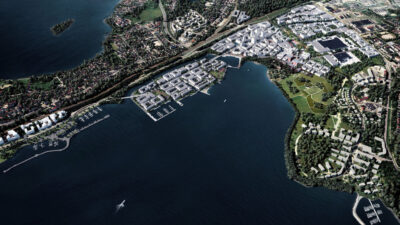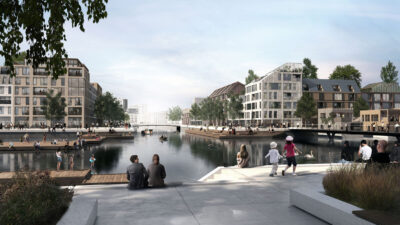The objective of Hiedanranta in Tampere is to function as a carbon sink. The project modelled the energy requirement of the future blocks and studied whether it would be sensible – from the perspective of energy efficiency in the area – to implement a low-energy network. In addition, the effects of heat storages and smart energy management on the heating network were also looked into.
The objective of the new Hiedanranta is to become a district for 25,000 residents and 10,000 jobs that also functions as a carbon sink. The aim is to build two-way, open energy networks through which the energy flows can be balanced between the so-called superblocks. Superblocks are large entities that bring together a large variety of housing and services, forming energy communities.
The goal of Hiedanranta is to produce more than what is consumed, in order to keep the environmental impacts of a dense urban area as low as possible. On the other hand, citizens cannot afford to live in the area if the solution is expensive. That is why we have examined, together with various experts, which solutions, on the one hand, mean very low emissions and, on the other hand, which solutions are inexpensive with respect to their life cycle costs.
Partners
Fluidit
Polar Night Energy
Sitowise
Granlund Consulting
Ramboll
Tampereen Sähkölaitos
Challenges
The energy transition is progressing rapidly, revolutionising conventional conceptions. For example, the production cost of solar power has collapsed during the past decade and in the Nordic Countries, wind power is, alongside nuclear power, the most inexpensive way to implement new electricity generation. Heat pumps have come to stay as part of the heating sector, and the production of renewable energy challenges the profitability of conventional power plants at the same time as traffic and heating become increasingly electrified. A reduction in the temperature of district heating networks could advance the utilisation of waste heat and the meeting of the heating and cooling requirements in an energy efficient way, but additional information on the advantages and possible disadvantages was required. In particular, it was asked what effects different kinds of seasonal storages of thermal energy would have on the energy system and whether the seasonal storages would be suitable for the energy system.
The problem is that there are risks in the introduction of new solutions. The implemented prices of the solutions are not readily available. The future development of energy prices also raises questions. The risks can partly be managed by using sensible ownership and operator models, which we have studied.
Objectives
The objective was to model the energy requirement of the blocks that are typical of Hiedanranta and to investigate whether it would be sensible – from the perspective of energy efficiency in the area – to implement a low-energy network. At the same time, the aim was also to examine the effects of heat storages and smart energy management on the heating network.
We studied nine scenarios. Conventional buildings and buildings that have been optimised utilising smart energy management, three cases: a conventional district heating network (the temperature of supply water 115..86 °C), a low temperature heating network (85..65 °C) and a heating network that has a very low temperature (55..40 °C). In addition, we studied buildings that have been optimised with a heat storage and we commented on the potential dealing with the utilisation of condensates.
After these studies, our goal was to find out the optimal meeting of the energy requirements of the entire Hiedanranta area with the help of life cycle costing and emissions calculation. At the same time, we also studied the advantages of the energy production distributed to the blocks and centralised energy production. In the final phase, we identified operating and ownership models for the optimal energy systems in the blocks and used the data for local detailed planning, designating space reservations for the production of renewable energy, energy networks and other energy solutions.
Results
The implemented simulations, analyses and calculations formed the energy simulation environment of the area, with the help of which new energy solutions can also be modelled as part of the energy solution of the area. The data that was produced by many actors and processed by experts is openly available on the website of the City of Tampere.
We stated that a low temperature heating network is a sensible solution for the utilisation of waste heat. The temperature level in the network affects the required size of pipes: in lower temperatures, larger pipes are required, but the differences in the investment costs for the network in different cases are moderate. A lower temperature in the network also reduces the heat loss from the pipes to their surroundings. A heating network that has a very low temperature saves up to 1–1.5% of the annual heating energy in the area, compared with a conventional heating network.
A heat storage is used for balancing an external district heating network by cutting down consumption peaks. The peak power of the heat storage is slightly below 10% of the required peak power. The power received from condensates is significant, particularly in summer. The feeding of the energy received from condensates into the heating network will chiefly not cause any additional measures for the network. The feeding is easiest in the case of a heating network that has a very low temperature.
The results of the operating models will be published at the end of 2020, and as part of the first local detailed plans of Hiedanranta, which will be completed in 2021.



